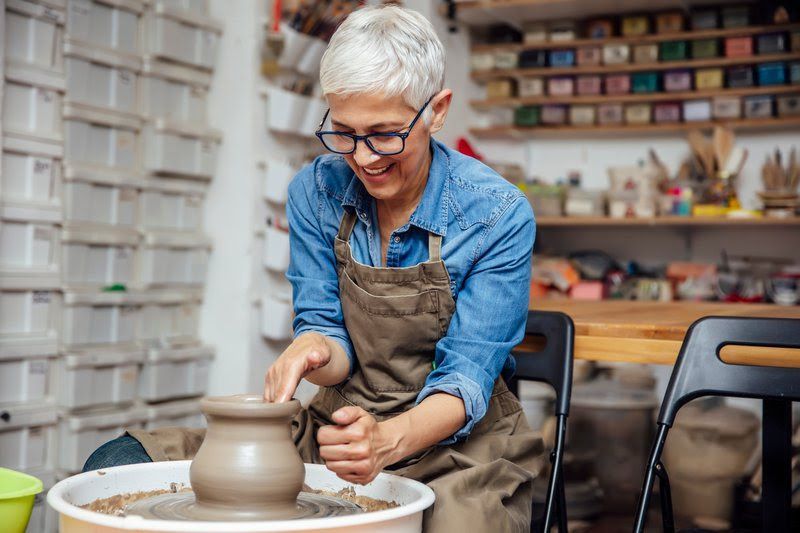BLOG
The Power of Art Therapy: Enhancing Creativity and Emotional Well-being in Senior Living
Art therapy has emerged as a powerful tool for enhancing creativity and emotional well-being among seniors in assisted living communities. By engaging in creative activities, residents can express emotions, reduce stress, and improve cognitive functions. Incorporating art therapy into senior care plans offers a holistic mental and emotional health approach. Assisted living facilities increasingly recognize the value of such programs in promoting residents' quality of life.
Integrating art therapy into daily routines at Assured Senior Living reflects a commitment to innovative, person-centered care. The facility fosters an environment of creativity and emotional support by providing residents with opportunities to explore various art forms.
The Psychological Benefits of Art Therapy
Engaging in art therapy allows seniors to process complex emotions in a nonverbal manner. Through creative expression, individuals can explore feelings that may be difficult to articulate. This process aids in reducing symptoms of depression and anxiety, which are common among the elderly.
Art therapy also promotes a sense of accomplishment and purpose. Completing an art project, regardless of its scale, can boost self-esteem and confidence. This sense of achievement is particularly beneficial for seniors facing physical or cognitive limitations. It reinforces their capabilities and fosters a positive self-image.
Furthermore, the creative process can distract from chronic pain or discomfort. Focusing on art projects diverts attention away from physical ailments, providing relief and improving overall quality of life. This therapeutic effect underscores the mind-body connection in holistic care approaches. Incorporating art therapy into pain management plans can be a valuable strategy in assisted living settings.
Art therapy also encourages mindfulness and present-moment awareness. Engaging in creative activities requires concentration, which can quiet the mind and reduce rumination on past or future concerns. This mindfulness aspect contributes to decreased stress levels and enhanced emotional regulation. Regular practice can lead to long-term improvements in mental health and resilience.
Improving Cognitive Function Through Art Therapy
Participating in art therapy stimulates various cognitive processes, including memory, attention, and problem-solving skills. Creating art engages multiple areas of the brain, fostering neural connections and cognitive resilience. This stimulation is vital for seniors to maintain mental sharpness and delay cognitive decline. Activities such as painting, drawing, or sculpting challenge the mind and encourage continuous learning.
Art therapy can also serve as a valuable tool for individuals with dementia or Alzheimer's disease. Creative activities provide alternative means of communication, allowing expression beyond verbal capabilities. This engagement can lead to moments of clarity and recognition, offering comfort to both residents and their families. Incorporating art therapy into dementia care plans can enhance the quality of life and emotional connection.
Moreover, the structured nature of art projects can improve organizational skills and executive functioning. Planning and executing an art piece requires decision-making and sequencing, which exercise the brain's executive centers. Regular participation in such activities can improve daily functioning and independence. This cognitive engagement is essential in promoting autonomy among seniors.
Engaging in group art sessions also enhances social cognition and empathy. Collaborative projects require understanding others' perspectives and emotions, fostering interpersonal skills. This social aspect of art therapy contributes to a supportive community environment. Enhanced social connections are linked to better cognitive health and reduced risk of cognitive decline.
Social Engagement and Community Building with Art
Art therapy sessions provide opportunities for social interaction, combating feelings of isolation prevalent among seniors. Group activities foster community and belonging, essential components of emotional well-being. Collaborative art projects encourage teamwork and communication, strengthening interpersonal relationships. These social connections are vital in creating a supportive and vibrant living environment.
Art groups allow residents to share personal stories and experiences through their creations. This sharing fosters empathy and understanding among peers, deepening social bonds. Celebrating each other's artistic achievements cultivates a culture of mutual support and appreciation. Such an environment enhances overall morale and satisfaction within the community.
Art exhibitions within the facility offer residents a platform to showcase their work. These events provide a sense of pride and accomplishment, validating their creative efforts. Family members and staff attending these exhibitions can strengthen the resident's support network. This recognition reinforces the value of their contributions and fosters a positive community atmosphere.
Intergenerational art programs can further enrich the social fabric of assisted living communities. By inviting local students or youth groups to participate in joint art projects, these programs bridge generational gaps. These interactions provide fresh perspectives and energy, invigorating the community. They also promote mutual learning and respect between different age groups, fostering meaningful connections.
Physical Benefits of Engaging in Art
Art therapy improves fine motor skills and hand-eye coordination. Activities like painting, sculpting, or beadwork strengthen hand muscles and enhance dexterity. This improvement is crucial for seniors who may experience arthritis or other mobility challenges. Regular participation can slow the decline in motor functions and maintain independence in daily tasks.
Additionally, the repetitive motions involved in art projects can relieve relaxation and stress. Studies suggest that engaging in creative activities reduces cortisol levels, the hormone responsible for stress. This relaxation effect contributes to lower blood pressure and an overall sense of calm. Art therapy can be particularly beneficial for seniors with hypertension or anxiety-related conditions.
Creating art also encourages movement, particularly in large-scale projects. Activities like mural painting, pottery, or weaving require broader arm and shoulder motions. These movements promote flexibility and reduce stiffness, supporting joint health. Assisted living communities can tailor projects to residents’ mobility levels, ensuring inclusive participation.
Sensory engagement through art therapy stimulates multiple senses, enhancing overall physical wellness. Mixing colors, handling different textures, and using various materials activate touch and visual perception. These sensory experiences can be especially beneficial for seniors with cognitive impairments, helping them stay connected to their surroundings. A multi-sensory approach to therapy enhances both physical and cognitive health.
Implementing Art Therapy in Assisted Living Communities
Assisted living communities can integrate art therapy through structured programs led by trained professionals. Certified art therapists specialize in guiding seniors through creative exercises tailored to their needs. Sessions can focus on emotional expression, cognitive stimulation, or social engagement. A well-rounded program ensures that residents experience the full benefits of art therapy.
Providing accessible art spaces within senior living facilities encourages regular participation. Designated art rooms equipped with materials such as paints, clay, and textiles create an inviting atmosphere. Accessibility considerations, such as ergonomic seating and adaptive tools, ensure inclusivity for residents with mobility challenges. Creating a dedicated space fosters a culture of creativity and self-expression.

Personalized art therapy plans enhance engagement by catering to individual interests and abilities. Some seniors may prefer watercolor painting, while others enjoy pottery or collage-making. Offering a variety of activities allows residents to explore different forms of expression. Individualized approaches maximize participation and therapeutic benefits.
Community involvement can enrich art therapy programs through partnerships with local artists and organizations. Visiting artists can lead workshops, introduce new techniques, and inspire creativity. Collaborations with museums or art institutions can provide exhibitions or field trip opportunities. Engaging with the broader arts community enhances the resident experience and fosters lifelong learning.
Regularly showcasing residents’ artwork fosters pride and recognition. Organizing art exhibitions, themed showcases, or virtual galleries celebrates creative achievements. These events provide a platform for residents to share their work with peers and family members. Acknowledging artistic contributions reinforces self-worth and encourages continued participation.
Embrace Art Therapy for a Fulfilling Senior Living Experience
Art therapy offers numerous benefits for seniors, from enhancing emotional well-being to promoting cognitive health. Through creative expression, residents can experience stress relief, social connection, and improved motor skills. Assisted living communities that incorporate structured art programs create enriching environments for residents.
At Assured Senior Living, we prioritize holistic approaches to care, including art therapy programs designed to engage and inspire residents. Our commitment to person-centered care ensures every resident has meaningful creative expression opportunities. Explore how our senior living communities integrate innovative therapies to enhance quality of life. Contact us today to learn more about our approach to personalized senior care.















